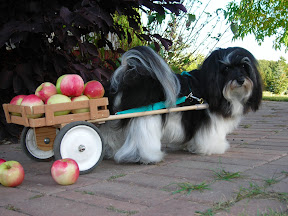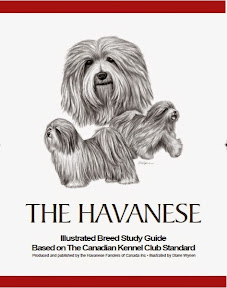
ABOUT US:
Havanese Fanciers of Canada (HFC), the national breed Club for the Havanese in Canada, aspires to high ideals of integrity and honour in all personal and public relationships so we may inspire confidence in our organization and merit the respect of the public we serve. We are the stewards of the breed and take that responsibility seriously. We are committed to the responsible promotion and protection of the Havanese breed in Canada.
We hope you find our site beneficial for all things Havanese. We are updating our functionality to provide easier use, French translation, and downloadable content.
Havanese Fanciers’ History
EARLY DAYS – Hav a what? In the 1980’s, references to Havanese were scattered and scarce; just enough to capture the interest of dog lovers looking for a unique little dog. It was not long before the first Havanese arrived in Canada. A few of the new arrivals were to become the foundation of breeding programs in Canada, others to become devoted and beloved family companions. Sylvia Diko, Verna Backus (Belvern) Cathy Enns (Jomaran), Connie Jacobson and Anne Dixon-Zborowski (Sineade) were some of the first Canadian Havanese breeders.
Verna Backus, in 1994, was a leading force in advancing the interests of the Havanese in Canada. Thanks to her efforts, along with other dedicated breed fanciers, the Havanese were entered into the Canadian Club Miscellaneous class beginning in 1996 under the name of “Bichon Havanais”.
CLUB BEGINNINGS – In November of 1998, Verna’s daughter Wanda Backus-Kelly and other Canadian breeders joined to form Canada’s first Havanese breed Club, the “Havanese Fanciers of Canada” (HFC). Wanda Backus Kelly (the first HFC president) along with Sandra Addison, Lynda Altman, Cyndi Brown, Anne Dixon-Zborowski, Stan and Pat Parkhouse, Sylvia Redl, Grace Westerson, Margaret Wettlaufer and Penny Will were the founding members of the Havanese Fanciers of Canada.
CKC breed recognition – The Havanese breed was fully recognized by the Canadian Kennel Club and accepted into the Toy Group in January of 2000.
Club accreditation – In March 2003, the Havanese Fanciers of Canada received CKC accreditation as the official National Breed Club for the Havanese in Canada.
Specialty – In August 2005, the Havanese Fanciers of Canada hosted the very first National breed Specialty in Canada in Winnipeg, Manitoba. Our National Specialty has become an annual event.
Rescue – In 2004, our rescue benefit auction (now a regular event) began as a fundraiser to raise awareness and resources for caring for Havanese in need.
November 2008 – HAPPY ANNIVERSARY, It has been 10 years since the Havanese Fanciers of Canada began. Today we have a vibrant and active Havanese community which stretches from coast to coast.
Havanese History
The Havanese (“Habaneros” in Spanish) is also known as the Havana Silk Dog. These little “charmers” are a part of the Bichon Family and are descended from the same bloodlines that produced the Water Spaniel, Poodle, and Portuguese Water dog. It is believed that during the days of the Spanish Empire they were brought to Cuba by sea captains to be sold to wealthy Cuban families as well as given as gifts to win the favour of wealthy senoras.
The breed is thought to have developed without outside influence and evolved unique adaptations for the hot cuban climate. It is a remarkably heat-tolerant dog, due to its unique coat. The coat is like raw silk floss, profuse, but extremely light and soft, and insulating against the tropical sun. In its native country, the coat was never clipped for this reason, and the hair never tied into a topknot, as the Cubans believe the hair protects the eyes from the harsh sun. It loves the water and is an accomplished swimmer.
By the mid-eighteenth century, they became very popular in Europe. Queen Victoria is said to have owned two and Charles Dickens had one called Tim, which was much beloved by his seven children. They were exhibited in the early European dog shows and type was well-established. In Cuba meanwhile, the times were changing. The aristocracy of the sugar barons was dying out and a new class was emerging, the bourgeoisie, and the little dog of Havana, adaptable as always, became an exceptional family dog, playmate of children, watchdog. It is a position he has held there for the past hundred and fifty years. It is said, though debated, that they were also a herder of the family poultry flock.
after the Cuban revolution, the Havanese began to die out except for a handful of them who found their way to the United States where they have slowly but steadily been rebuilt. All the Havanese in the world today, except for those from the “iron curtain” countries and those remaining in Cuba, stem from those 11 immigrants. Through out of their travels Havanese type has remained virtually unchanged from that of the dogs in the eighteenth century.
Link to: Havanese Official Breed Standard – C.K.C.
- Any issues, broken links or request please send to the webmaster at this link Web Changes
What’s New on the Site:
Newsletter:
We have a new Newsletter team and they have just delivered their first edition as a new team. It is filled with information and is just an excellent read. You can download our Winter edition from this link, but you can also find back copies under the menu Newsletters and Downloads. All newsletters are free to download for everyone.
